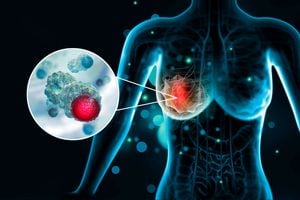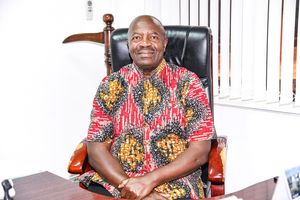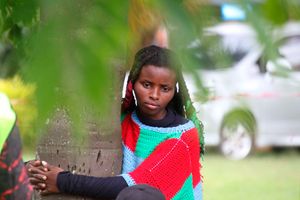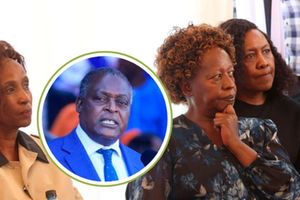Diary of a warrior: Our breast cancer journeys

Gerald Kuria, 72, was diagnosed with breast cancer four years ago.
What you need to know:
- Breast cancer kills more than two million people globally every year
Pointy silvery strands of hair sprout out of his balding scalp. He walks cautiously, his lanky frame a testament of the bruising battle he has endured. Gerald Kuria, 72, is a breast cancer survivor.
The Healthy Nation team meets Gerald, who was diagnosed with breast cancer at the age of 68, at his farm in Njoro, Nakuru County.
Gerald went through chemotherapy, surgery and radiotherapy for three years, which he says was a grueling period.
He has completed breast cancer treatment, and he now only goes for regular check-ups.
“I had noticed that my left breast was enlarging, but since it wasn’t painful, I shrugged it off until I started experiencing some pain in my chest on and off,” he narrates.
Gerald then confided in a neighbour, who worked as a pharmacist, and he was advised to go to Nakuru Teaching and Referral Hospital for further tests.
“At the hospital, doctors examined me and recommended that I get a biopsy done. This was done by removing a sample of tumour from the enlarged breast for further tests to determine if the lump was cancerous or not.”
Two weeks later, Gerald got the confirmation that he had stage three breast cancer and he would need to begin treatment immediately.
“I went through 36 rounds of chemotherapy. After the operation, I went for 15 sessions of radiotherapy and now I have a tablet that I take daily and will do so for the next five years.”
Surviving breast cancer at his age is nothing short of a miracle. His five family members have died of different types of cancer and so his diagnosis left him shocked and worried about his life.
“I lost my mother to cancer in 1979. She was followed by my four siblings and as their caregiver, I have firsthand experience on the excruciating pain a cancer patient undergoes.”
Luckily, Gerald’s diagnosis came at a time when Nakuru Teaching and Referral Hospital had established an oncology unit, and his medical insurance then under the National Health Insurance Fund (NHIF) subsidised his treatment.
“I owe my wife my life. I used her NHIF card to get treatment. NHIF would cover 75 per cent of the cost and I would top up the balance with cash. That made it manageable.”
For Gerald, his delay in getting treatment was in part due to shame and also the poor health seeking habits of men compared with women.
“I couldn’t find the courage to tell my wife that I had a lump in my chest. How could I even tell another man that I had a disease that mostly affects women?”
Feel unwell
But he says he has leant the lesson, and he wouldn’t hesitate to seek medical services whenever he feels unwell.
However, the status of Kenya’s healthcare system is giving him sleepless nights.
With the transition from NHIF to SHIF, Gerald is worried that he might fail to get services and medication in his next hospital review.
“The medication I am taking daily costs about Sh1,040 at the hospital’ s pharmacy. When it is out of stock, I have to buy it at the private pharmacies and it's usually three times that amount.”
Anne Kaniaru, another breast cancer survivor, narrates her experience. It’s been five years since she got her breast cancer diagnosis at the age of 24.
“I had lost my mother to breast cancer months earlier when I felt a lump in my breast.” Anne had just given birth to her first child and that gave the urgency to go to hospital for review.
“I went in for check-up at Nakuru Teaching and Referral Hospital and they conducted a biopsy.”
Two weeks later, the results came back.
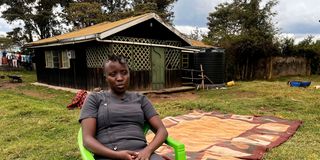
Anne Kaniaru, 29, a breast cancer survivor.
By the time Anne was submitting the results to the oncologist, she felt her fate had been sealed. She had been taking care of her mother, who had battled breast cancer for a decade. “It was quite an emotionally overwhelming period. I felt like my mother had died when I needed her the most. I was also afraid that I would suffer the same fate.”
After the breast cancer diagnosis, Anne was put on treatment immediately, starting with chemotherapy, surgery and then radiotherapy.
“I was opposed to getting a mastectomy because I was just 24 years old. I felt like I would be disfigured but the doctors told me that I needed the procedure to prevent future recurrence.”
As a young adult, navigating her cancer journey proved stressful due to the stigma she received from her peers.
“Going through chemotherapy sessions changed my appearance. I cut my hair and lost so much weight. The experience also revealed to me who my true friends were; some felt like cancer was contagious.”
Covering Anne's cost of treatment was also not easy since the family had been drained by the treatment of her late mother, and so when she exhausted her NHIF cover, donations from doctors carried her through.
“I had to travel to Nairobi for radiotherapy because Nakuru Teaching and Referral hospital did not have that facility then. I was getting those services at Nairobi Hospital, which was very expensive. When I shared my financial challenge with the doctors, they reached out to Faraja Cancer Center and that is how I was able to complete the radiotherapy sessions,” she says.
Her son was her motivation to keep fighting and stick to her medication. Now well into remission, Anne is a breast cancer awareness champion who spends her time at Nakuru Teaching and Referral Hospital’s Oncology Department offering support to those who have just began their cancer treatment journey.
“When I was being treated, I relied on survivors like me to give me hope. Now once a month I volunteer at the cancer survivors support group at the referral hospital to encourage those beginning their treatment journey.”
This breast cancer awareness month, Anne has been to schools and other public fora to spread the message of early detection and diagnosis. She is particularly focusing on young girls.
“I want the girls to know how to examine themselves. This is where it starts because most breast cancer lumps are not painful and by the time the pain starts, it has spread to other parts of the body,” she expalains.
According to Dr Dulcie Wanda, a radiation oncologist at Nakuru Teaching and Referral Hospital, a majority of cancer patients get to hospital in the late stages of the disease, a sign that a lot more effort needs to be put into public education on early cancer detection.
“Seventy to 80 per cent of cancer patients are coming at stage three and four because our awareness levels are low.”
The Breast Cancer Screening and Early Diagnosis Action Plan 2021-2025 identifies breast cancer as the most common type of cancer in Kenya and is the second leading cause of all cancer deaths. The report also sites that breast cancer cases have been on the rise from 2,553 in 2018 to 3107 in 2020.
The availability of cancer treatment outside Nairobi has also eased the burden on Kenyatta National Hospital and Moi Teaching and Referral Hospital, which were providing radiotherapy services to the more than 40,000 cancer patients in the country every year.
“Every day we have 20-30 patients receiving outpatient services at the oncology wing. We have another 20 -30 patients on chemotherapy and another 50 patients getting radiotherapy, and that is a huge number," says Dr Wanda
In Africa, breast cancer in men only accounts for six per cent of the breast cancer cases compared with one per cent of male breast cancer cases in the developed world. According to the World Health Organization, breast cancer kills more than two million people globally every year.
“Breast cancer in men is more aggressive than in women because women have breast tissue, where the tumour has space to grow inside,” explains Dr Wanda
In 2021, the World Health Organization launched the Global Breast Cancer Initiative to reduce mortality rates by 2.5 per cent per year by 2040 through health promotion for early detection, timely diagnosis; and comprehensive breast cancer management.
According to the Kenya Breast Cancer Early Screening and Diagnosis Action Plan 2021-2025 , nine in 10 breast cancer cases occur sporadically, while only five-10 per cent can be attributed to genetic predisposition.
Kenya still faces challenges in breast cancer control due to limited access to cancer preventive, diagnostic, treatment and rehabilitative services. There is also the shortage of cancer specialists, which Dr Wanda says is improving because doctors specialising in Oncology can now get the training locally.
“Previously for one to specialise, you would have to go abroad for that training but we have a programme at the University of Nairobi training radiation oncologists. The number of cancer specialists is now growing,” says Dr Wanda
By 2019, Kenya had 16 radiation oncologists, 35 oncology nurses, three nuclear medicine physicians, 27 therapy radiographers and 10 medical physicists.
“We need to humanise cancer and make it relatable and that is the role of advocacy where survivor share their experience to encourage those who haven’t be screened to get checked. We also need to work with the community health promoters to get the message to the grassroots.”
Doctors recommend that early cancer screening and diagnosis could help reverse the more that 27,000 cancer deaths recorded in the country every year.

